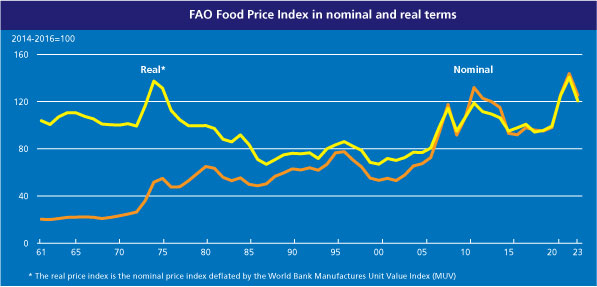FAO Food Price Index virtually unchanged in September

The FAO Food Price Index* (FFPI) averaged 121.5 points in September 2023, almost unchanged from its value in August, as declines in the price indices of vegetable oils, dairy and meat had offset increases in the sugar and cereal price indices. At this level, the index stood 14.6 points (10.7 percent) below its corresponding level a year ago and 38.3 points (24.0 percent) from the all-time high reached in March 2022.
» The FAO Cereal Price Index averaged 126.3 points in September, up 1.3 points (1.0 percent) from August but standing 21.6 points (14.6 percent) below its value a year ago. This month’s increase was led by a 5.3 percent increase in international coarse grain prices. After seven months of consecutive declines, international maize prices increased by 7.0 percent in September, driven by a confluence of factors, including strong demand for Brazil’s supplies, slower farmer selling in Argentina and increased barge freight rates due to low water levels on the Mississippi River in the United States of America. Among other coarse grains, world sorghum prices also firmed in September, in line with maize price trends, while barley prices remained essentially stable. By contrast, international wheat prices continued to drop, falling by 1.6 percent month-on-month, underpinned by ample supplies in the Russian Federation, where production prospects were lifted in September. The FAO All Rice Price Index edged slightly down by 0.5 percent month-on-month in September, while remaining as much as 27.8 percent above its year-earlier value. The slight decline in September was driven by generally low import demand, although price falls tended to be capped by lingering uncertainties regarding India’s rice export restrictions and progressively thinning supplies ahead of new-crop harvests in Asia.
» The FAO Vegetable Oil Price Index averaged 120.9 points in September, down 5.0 points (3.9 percent) from August, marking the second consecutive monthly decline. The fall in the index was driven by lower world prices across palm, sunflower, soy and rapeseed oils. International palm oil prices continued to decrease in September, chiefly underpinned by seasonally elevated production in major producing countries in Southeast Asia. Meanwhile, world sunflower oil quotations declined markedly, reflecting the harvest pressure of sunflower seed in the Black Sea region amid robust farmer selling activities. As for rapeseed oils, international prices declined on lingering abundant global export supplies, while world soy oil prices also followed suit, despite prospects of a firm demand from the biodiesel sector.
» The FAO Dairy Price Index averaged 108.6 points in September, down 2.6 points (2.3 percent) from August, marking the ninth consecutive monthly decline, and as much as 34.1 points (23.9 percent) below its value in the corresponding month last year. International prices across all dairy products declined in September, principally underpinned by lacklustre import demand for spot- and near-term deliveries amidst ample stocks in leading producing regions, despite an upsurge in demand towards the end of the month for some dairy products in Southeast Asian countries. In addition, rising export availabilities in New Zealand in its new production season, limited internal demand in the European Union, and the impact of a weaker Euro against the United States dollar weighed on international dairy prices.
» The FAO Meat Price Index* averaged 114.2 points in September, down 1.2 points (1.0 percent) from August, marking the third consecutive monthly decline, and 6.1 points (5.0 percent) from its value a year ago. International pig meat prices fell, underpinned by weak import demand from leading importing countries, especially China, and ample global export availabilities. World poultry meat prices also dropped, reflecting abundant supplies in leading global suppliers, especially Brazil. Ovine meat prices declined for the fifth straight month, albeit at a slower pace, driven by high supplies from Australia, despite steady demand from China and the Middle East. By contrast, strong import demand for lean bovine meat, especially in the United States of America, led to a rebound in international bovine meat prices, notwithstanding high export supplies from Brazil and Australia.
» The FAO Sugar Price Index averaged 162.7 points in September, up 14.5 points (9.8 percent) from August, marking the second consecutive monthly increase and reaching its highest level since November 2010. The hike in prices mostly stemmed from increasing concerns over a tighter global supply outlook in the upcoming 2023/24 season. This mainly reflects early forecasts pointing to production declines in key sugar producers, Thailand and India, due to drier-than-normal weather conditions associated with the prevailing El Niño event. Higher international crude oil prices also contributed to the increase in world sugar prices. However, the large crop currently being harvested in Brazil, amidst favourable weather conditions, combined with the weakening of the Brazilian Real against the United States dollar, limited the month-on-month increase in world sugar prices.
* Unlike for other commodity groups, most prices utilized in the calculation of the FAO Meat Price Index are not available when the FAO Food Price Index is computed and published; therefore, the value of the Meat Price Index for the most recent months is derived from a mixture of projected and observed prices. This can, at times, require significant revisions in the final value of the FAO Meat Price Index which could in turn influence the value of the FAO Food Price Index.


Read also
Wheat in Southern Brazil Impacted by Dry Weather and Frosts
Oilseed Industry. Leaders and Strategies in the Times of a Great Change
Black Sea & Danube Region: Oilseed and Vegoil Markets Within Ongoing Transfor...
Serbia. The drought will cause extremely high losses for farmers this year
2023/24 Safrinha Corn in Brazil 91% Harvested
Write to us
Our manager will contact you soon



